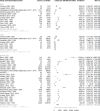Global incidence and mortality of neonatal sepsis: a systematic review and meta-analysis
- PMID: 33483376
- PMCID: PMC8311109
- DOI: 10.1136/archdischild-2020-320217
Global incidence and mortality of neonatal sepsis: a systematic review and meta-analysis
Abstract
Background: Neonates are at major risk of sepsis, but data on neonatal sepsis incidence are scarce. We aimed to assess the incidence and mortality of neonatal sepsis worldwide.
Methods: We performed a systematic review and meta-analysis. 13 databases were searched for the period January 1979-May 2019, updating the search of a previous systematic review and extending it in order to increase data inputs from low-income and middle-income countries (LMICs). We included studies on the population-level neonatal sepsis incidence that used a clinical sepsis definition, such as the 2005 consensus definition, or relevant ICD codes. We performed a random-effects meta-analysis on neonatal sepsis incidence and mortality, stratified according to sepsis onset, birth weight, prematurity, study setting, WHO region and World Bank income level.
Results: The search yielded 4737 publications, of which 26 were included. They accounted for 2 797 879 live births and 29 608 sepsis cases in 14 countries, most of which were middle-income countries. Random-effects estimator for neonatal sepsis incidence in the overall time frame was 2824 (95% CI 1892 to 4194) cases per 100 000 live births, of which an estimated 17.6% 9 (95% CI 10.3% to 28.6%) died. In the last decade (2009-2018), the incidence was 3930 (95% CI 1937 to 7812) per 100 000 live births based on four studies from LMICs. In the overall time frame, estimated incidence and mortality was higher in early-onset than late-onset neonatal sepsis cases. There was substantial between-study heterogeneity in all analyses. Studies were at moderate to high risk of bias.
Conclusion: Neonatal sepsis is common and often fatal. Its incidence remains unknown in most countries and existing studies show marked heterogeneity, indicating the need to increase the number of epidemiological studies, harmonise neonatal sepsis definitions and improve the quality of research in this field. This can help to design and implement targeted interventions, which are urgently needed to reduce the high incidence of neonatal sepsis worldwide.
Keywords: epidemiology; mortality; neonatology.
© Author(s) (or their employer(s)) 2021. Re-use permitted under CC BY. Published by BMJ.
Conflict of interest statement
Competing interests: CF received grants from the German Federal Ministry of Education and Research (BMBF) via the Center for Sepsis Control and Care (FKZ: 01EO1002 and 01EO1502) and from the Innovation Funds of the German Government (FKZ 01VSF17010). The other authors declared no competing interests.
Figures



References
-
- GBD 2017 Disease and Injury Incidence and Prevalence Collaborators . Global, regional, and national incidence, prevalence, and years lived with disability for 354 diseases and injuries for 195 countries and territories, 1990-2017: a systematic analysis for the global burden of disease study 2017. Lancet 2018;392:1789–858. 10.1016/S0140-6736(18)32279-7 - DOI - PMC - PubMed
-
- GBD 2017 Causes of Death Collaborators . Global, regional, and national age-sex-specific mortality for 282 causes of death in 195 countries and territories, 1980-2017: a systematic analysis for the global burden of disease study 2017. Lancet 2018;392:1736–88. 10.1016/S0140-6736(18)32203-7 - DOI - PMC - PubMed
-
- GBD 2013 Mortality and Causes of Death Collaborators . Global, regional, and national age-sex specific all-cause and cause-specific mortality for 240 causes of death, 1990-2013: a systematic analysis for the global burden of disease study 2013. Lancet 2015;385:117–71. 10.1016/S0140-6736(14)61682-2 - DOI - PMC - PubMed
Publication types
MeSH terms
Grants and funding
LinkOut - more resources
Full Text Sources
Other Literature Sources
Medical
